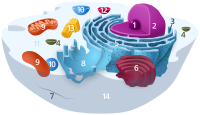
Photo from wikipedia
Viral internal ribosome entry sites (IRESs) are unique RNA elements, which use stable and dynamic RNA structures to recruit ribosomes and drive protein synthesis. IRESs overcome the high complexity of… Click to show full abstract
Viral internal ribosome entry sites (IRESs) are unique RNA elements, which use stable and dynamic RNA structures to recruit ribosomes and drive protein synthesis. IRESs overcome the high complexity of the canonical eukaryotic translation initiation pathway, often functioning with a limited set of eukaryotic initiation factors. The simplest types of IRESs are typified by the cricket paralysis virus intergenic region (CrPV IGR) and hepatitis C virus (HCV) IRESs, both of which independently form high-affinity complexes with the small (40S) ribosomal subunit and bypass the molecular processes of cap-binding and scanning. Owing to their simplicity and ribosomal affinity, the CrPV and HCV IRES have been important models for structural and functional studies of the eukaryotic ribosome during initiation, serving as excellent targets for recent technological breakthroughs in cryogenic electron microscopy (cryo-EM) and single-molecule analysis. High-resolution structural models of ribosome : IRES complexes, coupled with dynamics studies, have clarified decades of biochemical research and provided an outline of the conformational and compositional trajectory of the ribosome during initiation. Here we review recent progress in the study of HCV- and CrPV-type IRESs, highlighting important structural and dynamics insights and the synergy between cryo-EM and single-molecule studies. This article is part of the themed issue ‘Perspectives on the ribosome’.
Journal Title: Philosophical Transactions of the Royal Society B: Biological Sciences
Year Published: 2017
Link to full text (if available)
Share on Social Media: Sign Up to like & get
recommendations!